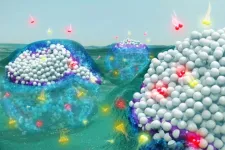(Press-News.org) Army scientists evaluated three nonhuman primate species as potential models of SARS-CoV-2 airborne infection, according to results published online this week in PLOS ONE. Their work demonstrates that any of these species may be useful for testing vaccines and therapies in response to the COVID-19 pandemic, which has resulted in over 104 million cases and more than 2 million deaths worldwide in the past year.
Given the global impact of COVID-19, experts are working rapidly to develop medical countermeasures, and testing in animal models is critically important to evaluate the efficacy of these products. Recent studies suggest that aerosol transmission may be the most prevalent route of human exposure to SARS-CoV-2, the virus that causes COVID-19. Until now, however, the African green monkey was the only nonhuman primate model studied in efforts to replicate airborne transmission of the virus.
In this paper, first author Sara C. Johnston, Ph.D., and colleagues at the U.S. Army Medical Research Institute of Infectious Diseases analyzed two additional nonhuman primate species as potential models of COVID-19 in humans.
The team exposed cynomolgus macaques, rhesus macaques, and African green monkeys to SARS-CoV-2 using a model system invented at USAMRIID that generates a controlled dosage of highly respirable airborne particles within a sealed chamber. Scientists then monitored the animals for up to 18 days, documenting clinical disease findings and comparing them to human cases. All three species developed disease that resembled mild acute respiratory disease in human patients, and all had corresponding viral loads in nasal and throat swabs. Respiratory abnormalities and viral shedding also were observed for all animals.
"In general, the clinical disease characteristics we noted are similar to those described by others in the field," Johnston commented. "One exception is the presence of fever in all cynomolgus macaques on this study. This finding was exclusive to cynomolgus macaques and was detected only by using implanted body temperature-monitoring devices. Since fever is a hallmark of COVID-19 for human patients, this represents an important clinical finding."
Developing animal models is a complex process, according to Johnston. Variables include the species selected, the dose of virus used, and the route of exposure, with the goal being to combine these elements to create a model that replicates human disease as closely as possible.
Overall, the USAMRIID data indicate that macaques, in addition to African green monkeys, can be infected by airborne SARS-CoV-2, providing natural transmission models for evaluation of vaccines and treatments.
"In addition to determining critical disease parameters associated with disease progression, and establishing correlations between primate and human COVID-19, this work directly contributes to the advancement of medical countermeasures against the virus," said USAMRIID senior author Aysegul Nalca, M.D., Ph.D. She said the team's next step is to demonstrate the utility of these primate models for the continuing evaluation of vaccine and therapeutic candidates. Having more than one viable model in place, she added, will help to facilitate a more rapid deployment of new medical products to mitigate the COVID-19 pandemic.
INFORMATION:
About the U.S. Army Medical Research Institute of Infectious Diseases:
For over 50 years, USAMRIID has provided leading edge medical capabilities to deter and defend against current and emerging biological threat agents. The Institute is the only laboratory in the Department of Defense equipped to safely study highly hazardous viruses requiring maximum containment at Biosafety Level 4. Research conducted at USAMRIID leads to medical solutions - vaccines, drugs, diagnostics, information, and training programs - that benefit both military personnel and civilians. Established in 1969, the Institute plays a key role as the lead military medical research laboratory for the Defense Threat Reduction Agency's Joint Science and Technology Office for Chemical and Biological Defense. USAMRIID is a subordinate laboratory of the U.S. Army Medical Research and Development Command. For more information, visit http://www.usamriid.army.mil.
Reference:
"Development of a Coronavirus Disease 2019 nonhuman primate model using airborne exposure" is available at this link:
https://journals.plos.org/plosone/article?id=10.1371/journal.pone.0246366
Authors:
Sara C. Johnston, Keersten M. Ricks, Alexandra Jay, Jo Lynne Raymond, Franco Rossi, Xiankun Zeng, Jennifer Scruggs, David Dyer, Ondraya Frick, Jeffrey W. Koehler, Paul A. Kuehnert, Tamara L. Clements, Charles J. Shoemaker, Susan R. Coyne, Korey L. Delp, Joshua Moore, Kerry Berrier, Heather Esham, Joshua Shamblin, Willie Sifford, Jimmy Fiallos, Leslie Klosterman, Stephen Stevens, Lauren White, Philip Bowling, Terrence Garcia, Christopher Jensen, Jeanean Ghering, David Nyakiti, Stephanie Bellanca, Brian Kearney, Wendy Giles, Nazira Alli, Fabian Paz, Kristen Akers, Denise Danner, James Barth, Joshua A. Johnson, Matthew Durant, Ruth Kim, Jay W. Hooper, Jeffrey M. Smith, Jeffrey R. Kugelman, Brett F. Beitzel, Kathleen M. Gibson, Margaret LM Pitt, Timothy D. Minogue, and Aysegul Nalca, all of USAMRIID
Funding:
This research was supported by the Military Infectious Diseases Research Program.
Philadelphia, February 4, 2021 - Researchers have leveraged the latest advances in RNA technology and machine learning methods to develop a gene panel test that allows for highly accurate diagnosis of the most common types of liposarcoma. It quickly and reliably distinguishes benign lipomas from liposarcomas and can be performed in laboratories at a lower cost than current "gold standard" tests. The new assay is described in The Journal of Molecular Diagnosis, published by Elsevier.
"Liposarcomas are a type of malignant cancer that is difficult to diagnose because, even under a microscope, it is hard to differentiate liposarcomas from benign tumors or other types ...
An assessment published this week in the journal The Lancet HIV provides new insight about an initiative to integrate treatment of opioid use disorder along with HIV in Vietnam.
The study marks one of the first scientifically robust assessments of a new model of treating HIV in lower or middle income countries where injection drug use is a major cause of HIV infection. It also suggests the importance of building support for peer and community connections to tackle the opioid epidemic that continues to ravage the United States in the midst of the COVID-19 pandemic.
The study was led by scientists and physicians at Hanoi Medical University and Oregon Health & Science University.
"Our study suggests that countries that ...
WOODS HOLE, Mass. -- Egg cells start out as round blobs. After fertilization, they begin transforming into people, dogs, fish, or other animals by orienting head to tail, back to belly, and left to right. Exactly what sets these body orientation directions has been guessed at but not seen. Now researchers at the Marine Biological Laboratory (MBL) have imaged the very beginning of this cellular rearrangement, and their findings help answer a fundamental question.
"The most interesting and mysterious part of developmental biology is the origin of the body axis in animals," said researcher Tomomi Tani. An MBL scientist in the Eugene Bell Center at the time of the research, Tani is now with Japan's National Institute of Advanced Industrial Science and Technology.
The work by Tani and ...
CHAMPAIGN, Ill. -- Chemical manufacturers frequently use toxic solvents such as alcohols and benzene to make products like pharmaceuticals and plastics. Researchers are examining a previously overlooked and misunderstood phenomenon in the chemical reactions used to make these products. This discovery brings a new fundamental understanding of catalytic chemistry and a steppingstone to practical applications that could someday make chemical manufacturing less wasteful and more environmentally sound.
The study led by University of Illinois Urbana-Champaign researcher David Flaherty, University of Minnesota, Twin Cities researcher Matthew Neurock and Virginia Tech researcher Ayman Karim is published in the journal Science.
Combining ...
For more than a century, optical coatings have been used to better reflect certain wavelengths of light from lenses and other devices or, conversely, to better transmit certain wavelengths through them. For example, the coatings on tinted eyeglasses reflect, or "block out," harmful blue light and ultraviolet rays.
But until now, no optical coating had ever been developed that could simultaneously reflect and transmit the same wavelength, or color.
In a paper in Nature Nanotechnology, researchers at the University of Rochester and Case Western Reserve University describe a new class of optical coatings, so-called Fano Resonance Optical Coatings (FROCs), that can be used on filters to reflect and transmit colors of remarkable purity.
In addition, ...
The rapid development of silicon-based transistors leads to its integration getting closer to the limit of Moore's law. Graphene is expected to become the next generation of mainstream chip materials due to its ultra-high carrier mobility. However, it is difficult to obtain a high on/off current ratio for intrinsic graphene-based transistor owing to the absence of bandgap. Graphene nanoribbons, which possess a tunable bandgap and unique optoelectrical properties, have attracted extensive attention and exploration.
Nowadays, the preparation of graphene nanoribbons is underdeveloped, and common strategies include the clip of carbon materials (graphene films, carbon nanotubes, or graphite) ...
When we think about the links to the future - the global transition to solar and wind energy, tactile virtual reality or synthetic neurons - there's no shortage of big ideas. It's the materials to execute the big ideas - the ability to manufacture the lithium-ion batteries, opto-electronics and hydrogen fuel cells - that stand between concept and reality.
Enter two-dimensional materials, the latest step in innovation. Consisting of a single layer of atoms, two-dimensional materials like graphene and phosphorene exhibit new properties with far-reaching potential. With a capability to be combined like Lego bricks, these materials ...
CLEVELAND--Researchers at Case Western Reserve University, using artificial intelligence (AI) to analyze simple tissue scans, say they have discovered biomarkers that could tell doctors which lung cancer patients might actually get worse from immunotherapy.
Until recently, researchers and oncologists had placed these lung cancer patients into two broad categories: those who would benefit from immunotherapy, and those who likely would not.
But a third category--patients called hyper-progressors who would actually be harmed by immunotherapy, including a shortened lifespan after treatment--has begun ...
PITTSBURGH, Feb. 4, 2021 - Researchers at UPMC Hillman Cancer Center and the National Cancer Institute (NCI) demonstrate that changing the gut microbiome can transform patients with advanced melanoma who never responded to immunotherapy--which has a failure rate of 40% for this type of cancer--into patients who do.
The results of this proof-of-principle phase II clinical trial were published online today in Science. In this study, a team of researchers from UPMC Hillman administered fecal microbiota transplants (FMT) and anti-PD-1 immunotherapy to melanoma patients ...
Despite living in the same part of the Mojave Desert, and experiencing similar conditions, mammals and birds native to this region experienced fundamentally different exposures to climate warming over the last 100 years, a new study shows; small mammal communities there remained much more stable than birds, in the face of local climate change, it reports. The study presents an integrative approach to understanding the climate vulnerability of biodiversity in rapidly warming regions. Exposure to rising temperature extremes threatens species worldwide. It is expected to push many ever closer toward extinction. Thus, understanding ...



